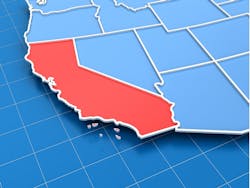The California Energy Commission (CEC) has provided $151 million in funding for grid resilience and safety research and demonstration projects, including microgrids, the agency said in an annual report on its Electric Program Investment Charge (EPIC) initiative.
By ymgerman/Shutterstock.com
EPIC-funded microgrids, like those installed at fire stations in Fremont, California, have proven their worth by keeping essential and emergency services running during power outages, the CEC said May 5 when it released an annual report on the program, which aims to help emerging technologies reach the market.
Since the EPIC program started in 2012, the CEC has granted 385 projects about $846 million, according to the report. The funding includes $207 million for grid decarbonization and decentralization.
In 2020, the CEC approved 54 new EPIC projects totaling almost $132 million, with nearly a third of the funding going to non-lithium energy storage demonstration projects, which can provide up to 20 times more storage than lithium-ion batteries, according to the agency.
Businesses raised $3.5 billion in private investment after receiving CEC funding and support, the agency said.
The California Public Utilities Commission (PUC) last year renewed the EPIC program through the end of this decade and gave it a $147.26 million annual budget through 2025, leaving a second five-year budget to be decided in the future. The program is funded by a surcharge on electric bills.
CEC to issue RFP for clean mobile generation
Looking ahead, the CEC plans to release a competitive solicitation for clean energy alternatives to mobile fossil fuel backup generators, according to the report. The agency didn’t say when the solicitation would occur.
The solicitation will seek mobile systems using renewable generation combined with energy storage to support communities during grid outages, including public safety power shutoffs, the CEC said. The agency said it will seek technology demonstration and deployment projects for systems that can support small or large loads. It will also look for applied research and development proposals for systems that can fully replace mobile fossil fuel systems that support larger loads.
PUC considers interim EPIC budget
The PUC is considering the CEC’s request for an interim EPIC budget that includes $41.2 million for applied research and development, $75 million for technology demonstration and deployment, and $16.3 million for market facilitation.
The interim request is a bridge to the CEC’s next EPIC budget plan, set to be filed with the PUC in October. The PUC is reviewing the interim budget proposal.
CEC eyes “value of resilience” research
The proposed interim budget would also help fund a new EPIC initiative that aims to develop ways to measure the societal benefits of grid resilience offered by microgrids, distributed generation and energy storage — a measure called value of resilience (VOR).
“Although issues related to extreme weather and other challenges to California’s grid have created strong interest in microgrids and other resilience investments, California’s state and local agencies currently lack a standardized approach for quantifying VOR,” the agency said.
Clarifying the societal benefits of resilience investments will help properly incentivize customer- and grid-resilience measures, the CEC said.
The need to appropriately value the benefits of resilience investments has emerged repeatedly in public workshops, including those on microgrids and climate adaptation, according to the agency.
The Clean Coalition, a California nonprofit, has developed a standardized VOR to help analyze potential microgrids.
Track news about California’s EPIC and funding for microgrids. Subscribe to the free Microgrid Knowledge Newsletter.







